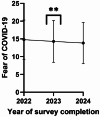The impact of COVID-19 fear during the later stages of the pandemic on maladaptive eating, psychological distress and body weight: a global cross-sectional study
- PMID: 40217216
- PMCID: PMC11987404
- DOI: 10.1186/s12889-025-22444-6
The impact of COVID-19 fear during the later stages of the pandemic on maladaptive eating, psychological distress and body weight: a global cross-sectional study
Abstract
Background: The COVID-19 pandemic significantly impacted global mental health, leading to increased levels of fear, stress, and anxiety [1]. Previous research has suggested associations between functional fear of detrimental mental health outcomes and psychological stressors which may drive maladaptive eating behaviors. This study explored the associations between COVID-19 fear during later stages of the pandemic, psychological distress (anxiety, depression, and stress), maladaptive eating behaviors (emotional, uncontrolled, binge, and nighttime eating), and self-reported body weight.
Methods: This was a global cross-sectional survey conducted from February 2022 to February 2024, involving 4390 adults (70% female) from 25 countries. The survey collected information on demographics, psychosocial impact, eating behaviors, and COVID-19 related behaviors. General linear models, multinomial logistic regression modes, and structural equation modeling were used to analyze the data.
Results: Higher fear of COVID-19 was significantly associated with increased emotional and uncontrolled eating, even after adjusting for psychological distress and other covariates. Specifically, each unit increase in fear of COVID-19 scores was associated with a corresponding increase in emotional eating (β = 0.018) and uncontrolled eating (β = 0.029) behaviors (p-values < 0.0001). Furthermore, fear of COVID-19 was linked to higher odds of engaging in binge eating (OR = 1.05, 95% CI: 1.03, 1.07, p-value < 0.0001) and nighttime eating behaviors (OR = 1.04, 95% CI: 1.03, 1.06, p-value < 0.0001) in models adjusted for covariates; however, these associations were no longer significant when psychological distress variables were included. Fear of COVID-19 was also associated with body weight (β = 0.18) and BMI (β = 0.08) even with adjustments of covariates and psychological distress variables (p-values < 0.01). Structural equation modeling showed that fear of COVID-19 was related to current body weight through its impact on psychological distress and maladaptive eating behaviors.
Conclusions: Maladaptive eating behaviors influenced by the psychological distress experienced during the COVID-19 pandemic have persisted into the later stages of the pandemic. These results underscore an interconnectedness between functional fear and its influence on maladaptive eating behaviors and body weight. Understanding this link is crucial and has the potential to inform the development of public health policies.
Trial registration: Clinical Trials.gov NCT04896060 Date of Registration: May 21, 2021.
Keywords: Anxiety; Binge eating; COVID-19; Depression; Disordered eating; Fear of COVID-19; Nighttime eating; Psychosocial impact; Stress; Weight gain.
© 2025. This is a U.S. Government work and not under copyright protection in the US; foreign copyright protection may apply.
Conflict of interest statement
Declarations. Ethics approval and consent to participate: This study was approved by the Institutional Review Board of the National Institute of Diabetes and Digestive and Kidney Diseases (DK000172) and conducted in accordance with the Declaration of Helsinki ethical standards. All volunteers provided written informed consent prior to beginning online survey. Consent for publication: Not applicable. Competing interests: The authors declare no competing interests.
Figures



Similar articles
-
A model of occupational stress to assess impact of COVID-19 on critical care and redeployed nurses: a mixed-methods study.Health Soc Care Deliv Res. 2024 Dec;13(23):1-32. doi: 10.3310/PWRT8714. Health Soc Care Deliv Res. 2024. PMID: 39708055
-
Physical interventions to interrupt or reduce the spread of respiratory viruses.Cochrane Database Syst Rev. 2023 Jan 30;1(1):CD006207. doi: 10.1002/14651858.CD006207.pub6. Cochrane Database Syst Rev. 2023. PMID: 36715243 Free PMC article.
-
Economic Deterioration and Social Factors Affecting Mental Health During the COVID-19 Pandemic in Japan: Web-Based Cross-Sectional Survey.JMIR Form Res. 2025 Jun 10;9:e65204. doi: 10.2196/65204. JMIR Form Res. 2025. PMID: 40493773 Free PMC article.
-
COVID-19-Related Increases in Depressive and Anxious Symptoms Are Associated with Maladaptive Eating Among Patients up to 4 years Post-bariatric Surgery.Obes Surg. 2024 Jul;34(7):2580-2586. doi: 10.1007/s11695-024-07326-x. Epub 2024 Jun 6. Obes Surg. 2024. PMID: 38839635 Free PMC article.
-
Antibody tests for identification of current and past infection with SARS-CoV-2.Cochrane Database Syst Rev. 2022 Nov 17;11(11):CD013652. doi: 10.1002/14651858.CD013652.pub2. Cochrane Database Syst Rev. 2022. PMID: 36394900 Free PMC article.
References
-
- Organization WH. Mental health and COVID-19: early evidence of the pandemic’s impact: scientific brief, 2 March 2022. In.; 2022.
-
- American Psychiatric Association. (n.d.). What are eating disorders? Retrieved January 7. 2025, from https://www.psychiatry.org/patients-families/eating-disorders/what-are-e...
-
- Rogers RW. A protection motivation theory of fear appeals and attitude Change1. J Psychol. 1975;91(1):93–114. 10.1080/00223980.1975.9915803. - PubMed
Publication types
MeSH terms
Associated data
LinkOut - more resources
Full Text Sources
Medical

